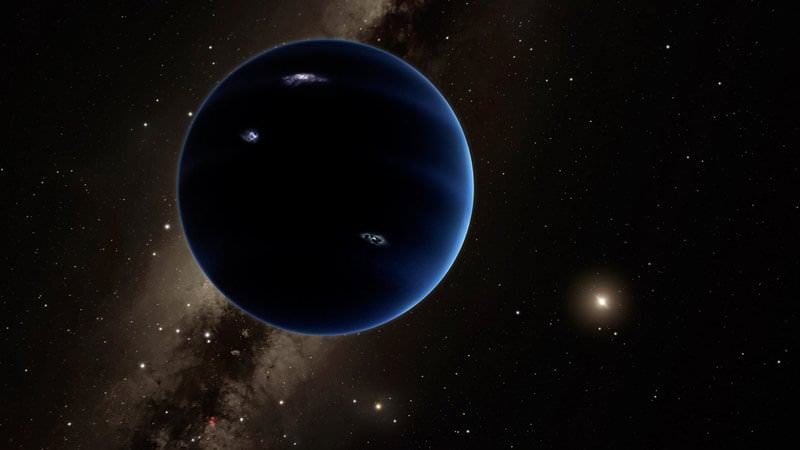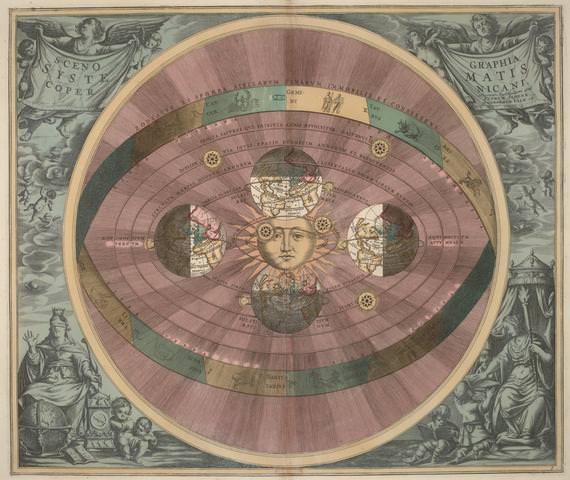How Long Would It Take To Travel To The Nearest Star?

Between existing and theoretical technology, it would take a very long time to get to Proxima Centauri, the nearest star. But it is possible...
Continue reading
Snowzilla's East Coast Blast Captured as 'Rare Thundersnow' by Scott Kelly on Station and Moonlit from Suomi Satellite

NEW JERSEY - NASA astronaut Scott Kelly captured a rare display of 'thundersnow' from space as Snowzilla's blast pummeled much of the US East Coast this weekend with two feet or more of blinding snow from the nations' capital to New York City and beyond.
Continue reading
This Road Leads to the Heart of the Milky Way

Stay on this road long enough and you'll reach the heart of the Milky Way, just 26,000 light-years to go.
Continue reading
Monster Blizzard of 2016 Strikes US East Coast, Tracked by NASA and NOAA Satellites

NEW JERSEY- The monstrous 'Blizzard of 2016' predicted by weather forecasters for days has struck a wide swath of the US East Coast from the Gulf coast to the Carolinas to New York and soon into New England, with full fury today, Friday, Jan. 22.
Continue reading
Why Haven't We Heard From All The Aliens? Because They're All Dead!

According to researchers from Australia National University, the reason humanity has found no evidence of alien life may be because it is extinct
Continue reading
Weekly Space Hangout – Jan. 22, 2016: Dr. Stuart Robbins

And Mercury Makes Five: See All Naked Eye Planets in the Sky at Once

A fine meeting of all five naked eye planets greets dawn skywatchers in early February as Mercury, Venus, Mars, Saturn and Jupiter are all visible at once. Watch as the Moon visits all five, and follow the planets through 2016.
Continue reading
NASA Completes Welding on Lunar Orion EM-1 Pressure Vessel Launching in 2018

In a major step towards flight, engineers at NASA's Michoud Assembly Facility in New Orleans have finished welding together the pressure vessel for the first Lunar Orion crew module that will blastoff in 2018 atop the agency's Space Launch System (SLS) rocket.
Continue reading
Extinction Alert: Stephen Hawking Says Our Technology Might Wipe Us Out

Astronomers Find Theoretical Evidence for Distant Gas Giant Planet in Our Solar System

The astronomer known worldwide for vigorously promoting the demotion of Pluto from its decades long perch as the 9th Planet, has now found theoretical evidence for a new and very distant gas giant planet lurking way beyond Pluto out to the far reaches of our solar system.
Continue reading
How Long Is A Day On The Other Planets Of The Solar System?

We are all familiar with how long a day is here on Earth. But how long is a day on the other planets of our Solar System?
Continue reading
Lights Out: A Fine Occultation of Aldebaran Spans the Atlantic

Reader images of the January 19th, 2016 occultation of the bright star Aldebaran by the waxing gibbous Moon. the event was visible across North America, the northern Atlantic, and Western Europe. Readers responded with Vines, pics, videos and more!
Continue reading
First Space Zinnia Blooms and Catches Sun's Rays on Space Station

The first Zinnia flower to bloom in space is dramatically catching the sun's rays like we have never seen before - through the windows of the Cupola on the International Space Station (ISS) while simultaneously providing a splash of soothing color, nature and reminders of home to the multinational crew living and working on the orbital science laboratory.
Continue reading
What Is The Plum Pudding Atomic Model?

The Plum Pudding Model, which was devised by J.J. Thompson by the end of the 19th century, was a crucial step in the development of atomic physics
Continue reading
Watch SpaceX Falcon 9 Rocket Almost Stick Droneship Landing, then Tip and Explode; Video

SpaceX came much closer to sticking the landing of their Falcon 9 rocket on a tiny droneship at sea than initially thought, as evidenced by a dramatic video of the latest attempt to recover the booster by making a soft ocean touchdown on Sunday, Jan. 17, after successfully propelling a US-European ocean surveillance satellite to low Earth orbit.
Continue reading
Carnival Of Space #441

Watch the Moon Occult Aldebaran Tuesday Night

Don't miss a fine occultation of the bright star Aldebaran by the waxing gibbous Moon on the evening of Tuesday, January 19th, visible across North America and the UK/western Europe.
Continue reading
NASA Jason-3 Sea Level Rise Reconnaissance Satellite Successfully Blasts off on SpaceX Falcon 9; Hard Landing on Barge

A SpaceX Falcon 9 rocket successfully launched the NASA/NOAA/European Jason-3 sea level rise reconnaissance satellite a short while ago today, Sunday, Jan. 17, from Vandenberg Air Force Base into a polar orbit around the Earth.
Continue reading
SpaceX Launching NASA Jason-3 Ocean Surveillance Satellite Jan. 17; with Barge Rocket Landing - Watch Live

The joint NASA-European ocean surveillance satellite named Jason-3 is poised for blastoff from SpaceX's California launch pad on Sunday, Jan. 17 - followed immediately by another Falcon 9 rocket recovery landing on a barge at sea. The weather forecast is outstanding! And you can watch all the excitement live.
Continue reading
SpaceX Test Fires Recovered Falcon 9 Booster in Major Step To Reusable Rockets

In a major advance towards the dream of rocket reusability, SpaceX successfully test fired the first stage engines of the Falcon 9 booster they successfully recovered last month - following its launch to the edge of space and back that ended with a history making upright landing at Cape Canaveral.
Continue reading
Weekly Space Hangout – Jan. 15, 2016: Dr. Steve B. Howell from Kepler
Dream Chaser Spaceplane Gets 'GO' as NASA Awards Trio of Space Station Cargo Contracts

A shuttle will soar again from American soil before this decade is out, following NASA's announcement today (Jan 14) that an unmanned version of the Dream Chaser spaceplane was among the trio of US awardees winning commercial contracts to ship essential cargo to the International Space Station (ISS) starting in 2019.
Continue reading
What Would Earth Look Like With Rings?

People have often wondered what Earth would look like if it had Saturn's rings. JPL's Kevin Gill lets them know with his new photoseries
Continue reading
Astronomy Cast Ep. 399: Women in Science
Dawn Unveils New Bright Features on Ceres in Striking Close-Ups

NASA's Dawn spacecraft has unveiled a new patch of intriguing bright features in the most recent series of striking close-up images taken just after the probe reached the lowest altitude it will ever reach during the mission.
Continue reading
What Are The Uses Of Electromagnets?

Electromagnets, which rely on electrical current to generate magnetic fields, are used to powering everything from medical equipment to consumer electronics.
Continue reading
SpaceX Trying Ambitious 2nd Rocket Recovery Landing in 4 Weeks

SpaceX is on course to move ahead with an ambitious spaceflight agenda, trying a 2nd rocket recovery landing of their Falcon 9 booster in barely 4 weeks time and upcoming this Sunday, Jan. 17, says Elon Musk, the billionaire founder and CEO of SpaceX.
Continue reading
Carnival of Space #440

Comet US10 Catalina: The Final Act

Comet C/2013 US10 Catalina puts on its final act this week through late January, as it crosses through northern hemisphere skies. Here's how to find it, what to expect, and some great images from Universe Today readers. The time to catch this bright binocular comet is this week!
Continue reading
What Is The Geocentric Model Of The Universe?

The geocentric model of the universe, in which the Sun, planets and stars revolved around the Earth, was the accepted view of the cosmos for millennia.
Continue reading
Space Zinnias Rebound from Space Blight on Space Station

Zinnia experimental plants growing aboard the International Space Station (ISS) have staged a dramatic New Year's comeback from a potential near death experience over the Christmas holidays, when traces of mold were discovered.
Continue reading
How Long Does It Take To Get To The Moon?

When space tourism gets underway, companies will have many options for getting people to and from the Moon, some faster than others.
Continue reading
"X" Marks the Spot of Convective Churning on Hot Pluto

"X" marks the spot that's illustrative of "convective churning" resulting from subsurface planetary heating, as seen in a fascinating new super high resolution image received from NASA's New Horizons spacecraft on Christmas Eve, Dec. 24, 2015.
Continue reading
Weekly Space Hangout – Jan. 8, 2016: Elizabeth S. Sexton-Kennedy from FermiLab

Understanding Juno's Orbit: An Interview with NASA's Scott Bolton

In this interview, we talk to NASA's Scott Bolton about the Juno Mission to Jupiter.
Continue reading
What Is The Atmosphere Like On Other Planets?

The Solar System's planets have varied and interesting atmospheres, ranging from incredibly thin exospheres to ones that could literally crush a person.
Continue reading
Spirit Rover Touchdown 12 Years Ago Started Spectacular Martian Science Adventure

Exactly 12 Years ago this week, NASA's now famous Spirit rover touched down on the Red Planet, starting a spectacular years long campaign of then unimaginable science adventures that ended up revolutionizing our understanding of Mars due to her totally unexpected longevity.
Continue reading
Book review: Success Strategies from Women in STEM

Have you ever wished that there was an instruction manual for life? "Success Strategies from Women in STEM" aims to be that book for women in research – a 'portable mentor' to help individual researchers find their way.
Continue reading
Solar Analemma 2015: A Year-Long Picture

If you took a picture of the Sun every day, always at the same hour and from the same location, would the Sun appear in the same spot in the sky? This fine image, compiled by astrophotographer Giuseppe Petricca from Italy, proves the answer is no.
Continue reading
What Is The Heliocentric Model Of The Universe?

In 1543, Polish astronomer Nicolaus Copernicus revolutionized astronomy by proposing his heliocentric model of the Universe
Continue reading
What's Ahead for Recovered SpaceX Falcon 9 Booster?

Now that SpaceX has successfully and safely demonstrated the upright recovery of their Falcon 9 booster that flew to the edge of space and back on Dec. 21 - in a historic first - the intertwined questions of how did it fare and what lies ahead for the intact first stage stands front and center.
Continue reading
Watch Venus Brush Past Saturn This Weekend

Watch Venus pass less than five arc minutes from Saturn on Saturday, January 9th in one of the closest conjunctions of two naked eye planets in 2016. The Moon will also pay the pair a visit this week, as comet US10 Catalina hovers near naked eye visibility in the dawn. It's a great way to kick off astronomy in 2016!
Continue reading
Astronomy Cast Ep. 398 - Seeing Things: Emitting, Reflecting, Ionizing Light Sources
Gorgeous Views of Earth from Space Ring in New Year 2016 From the Space Station and Beyond

Happy New Year 2016 from the International Space Station and Beyond! Behold Earth ! Courtesy of our Human and Robotic emissaries to the High Frontier we can ring in the New Year by reveling in gorgeous new views of our beautiful Home Planet taken from the space station and beyond.
Continue reading
Will 2016 Be the Year Elon Musk Reveals his Mars Colonial Transporter Plans?

There are several space stories we're anticipating for 2016 but one story might appear -- to some -- to belong in the realm of science fiction: in the coming year Elon Musk will likely reveal his plans for colonizing Mars.
Continue reading
Orbital ATK Integration of Upgraded Antares Kicks Into High Gear For 2016 'Return to Flight'

NASA WALLOPS FLIGHT FACILITY, VA - Assembly and testing of a significantly upgraded version of Orbital ATK's commercially developed Antares rocket has kicked into high gear and is on target for rebirth - as the clock ticks down towards its 'Return to Flight' by approximately mid-2016 from a launch pad at the Mid-Atlantic Regional Spaceport (MARS) in Virginia, company managers told Universe Today during a recent up close visit to see the actual flight hardware.
Continue reading
Pluto Has Been Explored, Here Are The Stamps To Prove It

Pluto has been explored, and now the USPS has released new stamps to celebrate this accomplishment. And that's not all, more planets, the Moon and Star Trek?
Continue reading
How Many Moons Does Mercury Have?

The planet Mercury has no moons, but why is that the case? The reason is due to a combination of its small size, orbit, and weak gravity.
Continue reading
Giveaway: One More Chance to Win the 2016 Year in Space Calendar

Still looking for the perfect calendar for 2016? Don't start the year without the new Year In Space Wall Calendar!
Continue reading
 Universe Today
Universe Today